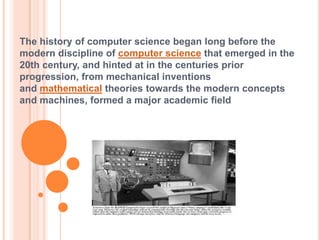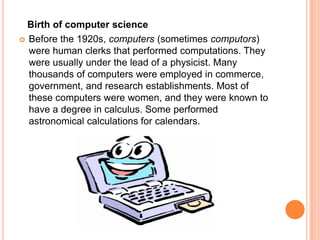Computer history
- 1. COMPUTER 20090239 ENG 204 GÃLÅEN HÃSEYÄ°N MUSTAFA DOLMACI
- 2. The history of computer science began long before the modern discipline of computer science that emerged in the 20th century, and hinted at in the centuries prior progression, from mechanical inventions and mathematical theories towards the modern concepts and machines, formed a major academic field
- 3. ïĒ The earliest known tool for use in computation was the abacus, developed in period 2700â2300 BC in Sumer. The Sumerians' abacus consisted of a table of successive columns which delimited the successive orders of magnitude of their sexagesimal number system.[2] Its original style of usage was by lines drawn in sand with pebbles. Abaci of a more modern design are still used as calculation tools today.
- 4. Binary logic ïĒ In 1703, Gottfried Leibnitz developed logic in a formal, mathematical sense with his writings on the binary numeral system. In his system, the ones and zeros also represent true and false values or onand off states. But it took more than a century before George Boole published his Boolean algebra in 1854 with a complete system that allowed computational processes to be mathematically modeled.
- 5. ïĒ By this time, the first mechanical devices driven by a binary pattern had been invented. The industrial revolution had driven forward the mechanization of many tasks, and this included weaving. Punched cards controlled Joseph Marie Jacquard's loom in 1801, where a hole punched in the card indicated a binary one and an unpunched spot indicated a binary zero. Jacquard's loom was far from being a computer, but it did illustrate that machines could be driven by binary systems.
- 6. Birth of computer science ïĒ Before the 1920s, computers (sometimes computors) were human clerks that performed computations. They were usually under the lead of a physicist. Many thousands of computers were employed in commerce, government, and research establishments. Most of these computers were women, and they were known to have a degree in calculus. Some performed astronomical calculations for calendars.
- 7. ïĒ After the 1920s, the expression computing machine referred to any machine that performed the work of a human computer, especially those in accordance with effective methods of the Church-Turing thesis. The thesis states that a mathematical method is effective if it could be set out as a list of instructions able to be followed by a human clerk with paper and pencil, for as long as necessary, and without ingenuity or insight.
- 8. ïĒ Machines that computed with continuous values became known as the analog kind. They used machinery that represented continuous numeric quantities, like the angle of a shaft rotation or difference in electrical potential.
- 9. Wiener and Cybernetics ïĒ From experiments with anti-aircraft systems that interpreted radar images to detect enemy planes,Norbert Wiener coined the term cybernetics from the Greek word for "steersman." He published "Cybernetics" in 1948, which influenced artificial intelligence. Wiener also compared computation, computing machinery, memory devices, and other cognitive similarities with his analysis of brain waves.
- 10. ïĒ The first actual computer bug was a moth. It was stuck in between the relays on the Harvard Mark II.[1] While the invention of the term 'bug' is often but erroneously attributed to Grace Hopper, a future rear admiral in the U.S. Navy, who supposedly logged the "bug" on September 9, 1945, most other accounts conflict at least with these details. According to these accounts, the actual date was September 9, 1947 when operators filed this 'incident' â along with the insect and the notation "First actual case of bug being found.
- 11. ïĒ REFERENCES http://en.wikipedia.org/wiki/History_of_computer_science



![ïĒ The earliest known tool for use in computation was
the abacus, developed in period 2700â2300 BC
in Sumer. The Sumerians' abacus consisted of a table
of successive columns which delimited the successive
orders of magnitude of their sexagesimal number
system.[2] Its original style of usage was by lines drawn
in sand with pebbles. Abaci of a more modern design
are still used as calculation tools today.](https://image.slidesharecdn.com/computerhistory-120325102743-phpapp01/85/Computer-history-3-320.jpg)






![ïĒ The first actual computer bug was a moth. It was stuck
in between the relays on the Harvard Mark II.[1] While
the invention of the term 'bug' is often but erroneously
attributed to Grace Hopper, a future rear admiral in the
U.S. Navy, who supposedly logged the "bug" on
September 9, 1945, most other accounts conflict at least
with these details. According to these accounts, the
actual date was September 9, 1947 when operators filed
this 'incident' â along with the insect and the notation
"First actual case of bug being found.](https://image.slidesharecdn.com/computerhistory-120325102743-phpapp01/85/Computer-history-10-320.jpg)
